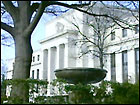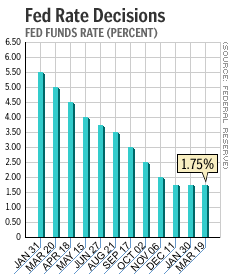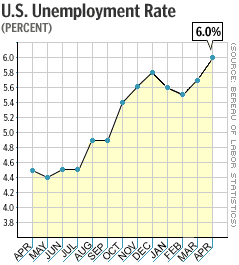
NEW YORK (CNN/Money) -
The Federal Reserve is scheduled to meet Tuesday to discuss its target for short-term interest rates, and it's almost certain to leave them alone, with the strength of the U.S. economy's recovery from recession still in doubt.
The Fed will eventually have to start raising rates again; its current target for the key federal funds rate, which banks use to lend money to each other overnight, is at 1.75 percent, a 40-year low.
But it's almost impossible to tell when the rate hikes will begin. If the economy recovers with gusto from a recession that likely began in March 2001, inflation could quickly become a worry, forcing the Fed to raise rates soon.
On the other hand, with unemployment rising to 6 percent in April, the highest level in more than 7 years, and corporate profits slow to recover, many observers worry the economy will be as anemic this year as it was following the 1990-91 recession, forcing the Fed to keep rates low.
There's even the outside chance that central bank policy makers could leave rates alone all year -- or maybe cut again.

"The first tightening is so far away that anything could happen between now and then," said Rory Robertson, interest rate strategist at Macquarie Equities USA."If jobs growth remains very weak and the downtrend in equity prices continues, it is possible that the consensus that the next move in rates is up will be turned on its head."
Meanwhile, inflation is a distant memory. Both the consumer price index and the lesser-known -- but possibly more important to the Fed -- price index for the personal consumption expenditures component of gross domestic product (GDP) are growing timidly and have been for several months.
"Unemployment at 6 percent means the Fed has just lost six full years of progress towards lower unemployment in just six quarters," Robertson said. "With its preferred measure of core inflation at the lowest level since the 1960s, the Fed probably requires a run of monthly payroll gains of 150,000 to 200,000 before it will feel any real need to tighten."
The last time the economy added 150,000 in consecutive months was between February 1999 and May 2000 -- during which period the Fed raised interest rates six times.
And history is another indicator that the Fed could sit on its hands in 2002. Following the past four recessions, it left rates alone for a year and a half and in some cases even cut rates during that time, pointed out former Fed economist Lara Rhame, now with Brown Brothers Harriman.
"I would not bat an eye if you told me the Fed was going to keep rates low the rest of year," she said.
The optimistic view
The Fed is scheduled to meet six more times this year. None of the 21 economists polled by Reuters expected a rate hike Tuesday, and only one expected an increase at its next meeting in June.

But 16 of those economists expected a quarter-percentage-point increase in August, and the consensus view of the economy is that it will grow steadily this year. After all, a rising unemployment rate is normal in the months following a recession, as unemployed workers start looking for jobs again, while companies -- who have learned to operate more productively during the downturn -- wait to see if the recovery is for real.
"To me, the business cycle is working as it always does, absent an external shock," said Fleet One chief economist Wayne Ayers, formerly a Fed economist. "Inventory liquidation means firms have to increase production, and they're already doing that. They're also increasing the length of the work week and hiring temporary workers. All these things support income and spending."
Any improvement in the labor market would be a big difference from the past year, when businesses slashed more than a million jobs. And consumers spent money last year anyway, despite the job cuts and despite the Sept. 11 terror attacks.
Many economists thought that the whopping 6.1 percent gain in spending in the fourth quarter, driven by desperate retailer incentives such as zero-percent financing on automobile loans, would "steal" growth from following quarters. But spending grew by 3.5 percent in the first quarter, the second-biggest gain since the third quarter of 2000.
"As the job market gradually improves, it should easily support consumer-spending gains of at least 3.5 percent this year," said Merrill Lynch chief economist Bruce Steinberg.
Combined with expected gains in government spending and the end of a year-long process of slashing business inventories, such gains in consumer spending would boost GDP growth the rest of the year to an average of 4.5 percent, said Steinberg, who expects the Fed to add at least to 1.25 percentage points to its target for the fed funds rate this year.
The Fed cuts rates to stimulate consumer spending, which makes up about two-thirds of U.S. GDP. Lower rates ease the cost of short-term borrowing, putting more money in consumers' pockets. The Fed's latest round of cuts, which began in January 2001, also drove mortgage rates lower, fueling a red-hot housing market that also helped the economy.
| |
 Related links
Related links
| |
| | |
| | |
|
But Fed Chairman Alan Greenspan has said that the economy's return to strength this year will depend finally on a rebound in business spending. After all, the latest recession was triggered in part by a dramatic slowdown in business spending in late 2000 and early 2001, the hangover from a bubble in the late 1990s.
One ominous sign that businesses won't spend any time soon is the unusual activity of the stock market, which has fallen this year despite the expected end of an recession and a prolonged profit slump."
"Stocks usually lead us out of a recession, but not this time," said Rhame of Brown Brothers Harriman. "That throws in a whole new level of uncertainty about how businesses are going to behave. We don't know if there will be enough business confidence without stocks coming back."

|

